In the past, they were the domain of keen individuals that went through the hassle and expense of shipping them personally.
Most local retailers would offer kayaks that were mainly designed for paddling long distances and/or were rudder dependent.
Honestly, there really was not much choice for somebody desiring a performance close-fitting boat.
Available kayaks had huge hulls, high decks and most times an ill fitting cockpit.
I used to envy paddlers in North America and Great Britain: they had a huge choice available to them.
A few years ago skegged boats started to gain popularity here and only very recently some paddlers desired kayaks that are body fitting.
While the majority of paddlers are seeking a kayak that gets them on the water and allows them to explore the sheltered shores, some kayakers are discovering the fun that rolling brings.
Yes, you read it right: rolling can be fun.
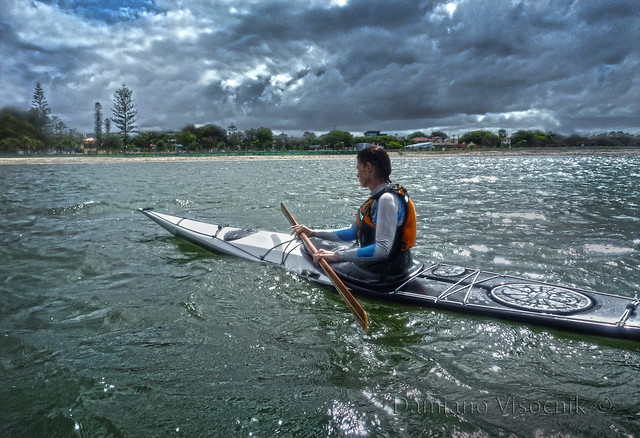
Most paddlers are content learning to roll as a mean to self rescue in an accidental capsize. My circle of friends of dedicated kayakers view rolling more than just a practical skill; they like rolling for the sake of rolling.
Once we learned the basic roll to right ourselves back up we started to explore the possibility of different rolls.
Introduced to traditional paddles, we were no longer satisfied with just a forced marginal “all paddle” powered roll; we sought variety.
It’s hard to explain to a non roller what it feels like to be confident underwater and enjoy the feeling of being immersed upside down to then gently rotate your body and rise to the surface with grace.
A lot of our rolls require a lay back position onto the rear deck of the kayak that lowers the centre of gravity.
Unfortunately not many kayaks are designed with a lower rear deck.
Most kayaks are bulky and offer maximum cargo space often sacrificing maneuverability.For the last couple of years I have observed a growing trend towards a more graceful paddling style where control of the boat is performed by edging of the hull instead of just pressing on the rudder pedals.
The ultimate kayak for this type of paddling is a Greenland style kayak.
Typically recognized by a low profile with a low rear deck and hard chined hull.
Importer Craig McSween of Adventure Outlet now has 3 different kayaks in stock that follow this design philosophy, all from Tahe Marine.
Already familiar with the performance of the Tahe Greenland, I was interested in trying out the larger siblings: the Tahe Greenland T and the Sea Spirit.
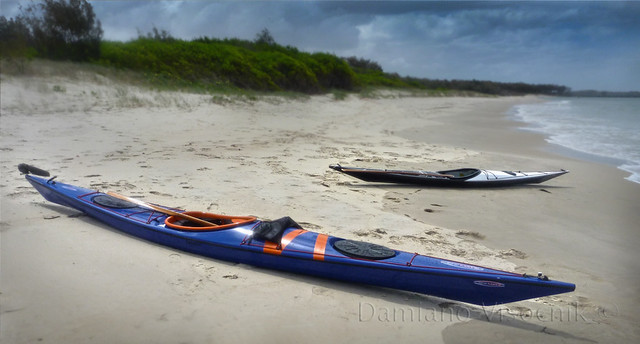
Craig was generous to allow us to test paddle them one afternoon in the relatively sheltered water of the Gold Coast Broadwater.
Conditions were mild: wind gusts of max 15 knots with little or no waves with a max of 1 knot of current.
The Greenland T is regarded as true Greenland form while I think that the Sea Spirit is more an all round kayak of Greenland style.
The T is a bit larger than the classic Greenland, a bit beamier and a slightly higher deck: unfortunately still too small for my large thighs and big feet.
Vanilla fitted the T well and Adventuretess found it roomy enough for possible all day paddles with a bit of wiggle room.
(Vanilla’s personal kayak is an Impex Force5 and Tess’ preferred kayak is her Nordkapp LV).
The T and Sea Spirit have a keyhole cockpit making entry/exit a bit easier than the traditional “ocean style” cockpit on the Tahe Greenland.
We had no means for scientifically measure max speeds of these kayaks but I don’t think they are designed as sprinting vessels.
Having a shorter waterline they accelerated easily and to maintain a cruising speed of 6-7km/h required little effort. The kayaks will start to hit the “hull speed wall” sooner than a long kayak.
However, because of their reduced wetter surface they will be easier to paddle, at club paddling pace, than a longer kayak.
The finish and the attention to detail on Tahe kayaks are superb. The external seam is a narrow black Kevlar tape that has a clear textured finish. Extremely neat.
There were no visible print through areas in the gel coat. The inside of the cockpit is finished with flow coat to prevent any possible fiberglass rash where the body contacts the deck.
The hatch covers (Kajak Sport lids), while very easy to secure/remove, maintained a dry interior during our prolonged rolling session.
select 360p to view vidoe if you don't have a fast internet connection
I believe that Tahe kayaks are a very good value for money alternative to the well established brands offered locally.
They might not be the ultimate bombproof expedition hulls of some British kayaks but they weigh and cost substantially less.
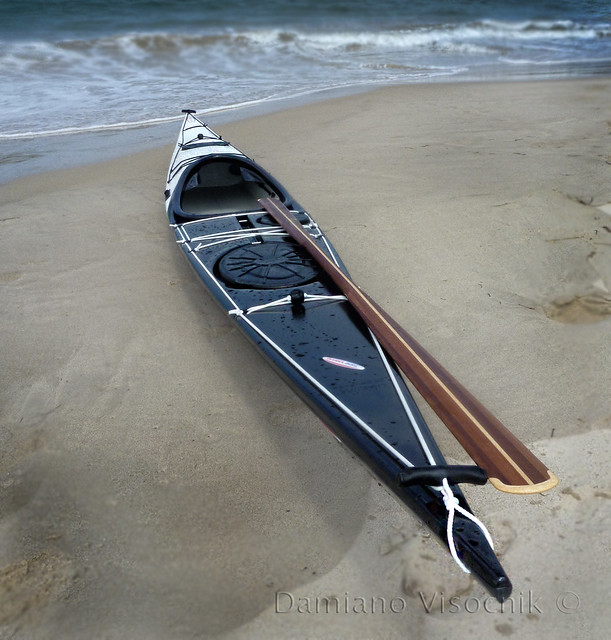
A novice might find the T a bit on the “tippy” side while the wider hull Sea Spirit will instill more confidence, in a beginner.
The T was fitted with a skeg and the Sea Spirit had a rudder (skeg also available).
In beam winds the T weather cocked minimally (a bit of edging was necessary if no skeg deployed). The Sea Spirit displayed no tendency of turning into the wind. Tess didn’t use the rudder (a spring loaded over-stern design that retracts onto the deck when not deployed) while Vanilla used it.

I did not like the rather diminutive back band on the T: maybe it was not adjusted well but kept on sneaking too low on my butt. It would be a real challenge to find a back band that would be supportive enough but still out of the way when lying back over the low rear deck.
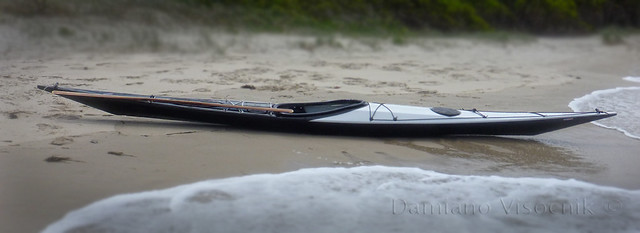
Greenland style kayaks have a hard chined hull that allow for fast maneuvering. Edging drastically changes the footprint of the submerged hull resulting in sharper handling than a round hull.
Hard chines promote and “engaged” paddling style where the kayaker uses his/her body to direct the kayak instead of relying on the rudder.
Both kayaks are fitted with integrated thigh braces allowing a good contact with the body for a positive retention when rolling.
I see the Sea Spirit as a very good learning kayak that still rewards an intermediate paddler that is interested in advanced techniques.As expected both kayaks were outstanding rollers, compared to a higher rear decked one.
Both Vanilla and Tess (not expert rollers) could perform moves that are challenging in their own kayaks.
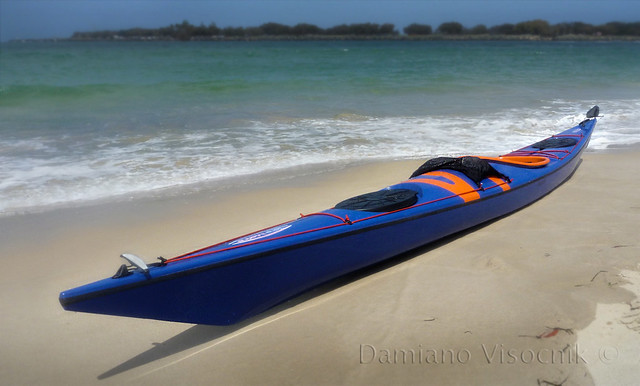
I believe the Sea Spirit would also be an ideal kayak for the beginner aspiring to become a proficient paddler seeking control of the boat.
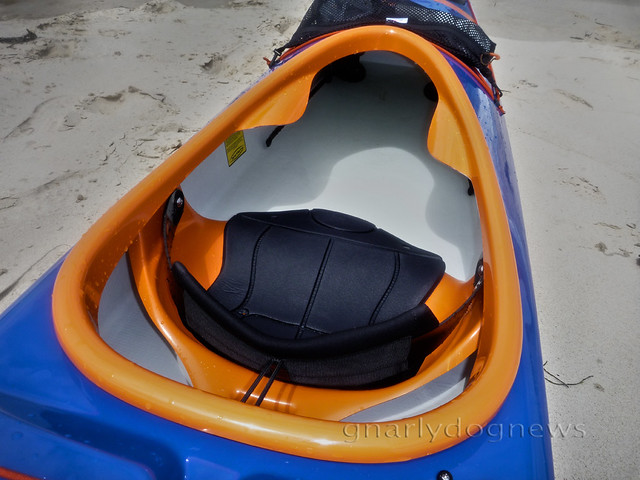
The seats in these kayaks are hung (bolted) from the deck and supported on the hull with a positive fastener that prevents them from swinging and potentially fail due to stress on the hanger (something that has happened on several kayaks of mine).
I found the Sea Spirit’s thigh braces too low and my legs would not fit comfortably under the deck. Unfortunately that is the case with the majority of performance kayaks: my legs are larger than average.
Adventuretess thought that the thigh braces were great. Vanilla would like to see them just a bit higher (or possibly modified by cutting away a small section of fiberglass).
Tahe offers solid foot pegs that are really easy to adjust, even while seated in the cockpit.
Swapping foot reach between Vanilla and Tess was a breeze: no need to undo any bolts or force a stubborn footpegs into the new position. On long paddles, if needed, one can simply reach below deck, twist a little shaft and reposition the pegs in a different location.
The Sea Spirit had only two hatches and lacked the typical day hatch behind the cockpit. Instead it had a nice low profile mesh bag in front of the cockpit.
I like Tahe’s philosophy on this one: to be able to offer a budget kayak (current retail of under $2600) they reduced the features instead of the quality.
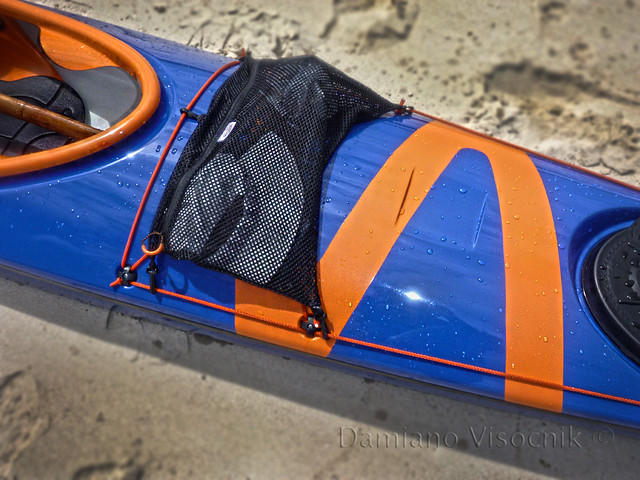
So far I have only had the opportunity to trial just a few of the kayaks from the extensive range available at Adventure Outlet.
Maybe one day I might even try one of the ruddered kayaks :-)



Pretty boats. Do you not forward cant your Greenland sticks when paddling?
ReplyDeletesharp eye there, Silbs.
ReplyDeleteAdventuretess is paddling here with a GP while Vanilla uses an Aleut.
Tess is still learning the subtle technique of efficient GP use since she has been paddling with an Aleut paddle for a couple of years and only recently acquired a GP.
I believe Aleut paddles don't need as much canting as GPs because of the strong dihedral shaped power face.
Myself included, we are still perfecting the use of the GP.
You mentioned the backband on the Greenlander Touring. In my touring i removed the backband and replaced it with a block of foam. Its shaped with a curve on top that ends at the top of the cockpit coaming. That makes rolling more comfortable for me :-)
ReplyDeleteMore or less like this, except a bit higher and wider http://www.seakayakgeorgia.com/catalog.php?item=22&new=yes
Anonymus, that would be a great solution for this low rear decked kayak.
ReplyDeleteI have done that very modification to a Nordkapp LV and works great.
I have noticed some manufacturers adopting that solution in some of their performance kayaks now.
Gnarly, who made that stick that Tess is using? It is absolutely beautiful!
ReplyDeleteFP, Tess' Greenland paddle is a laminatedhollow core limited edition Greg Schwarz creation.
ReplyDeleteMore details at: http://gnarlydognews.blogspot.com/2010/01/hollow-core-greenland-paddle.html
I have been told by my kayak teacher/advicer, somebody with long exsperiance that Nortkapp LV is the ideal boat for me but bit out of my price range right now. On the other hand i have been looking at the Greenland T it sounds very good on paper. Is it possible to comper thoes two in some way ?
ReplyDeleteHello,
ReplyDeleteI was wondering if the seaspirit is fine for someone with limited experience trying to get a 3 * BCU.
I'm not sure either if is suitable based on my height (184cm) and weight (84kg).
I will appreciate your thoughts on this.
Stelios, you and me share the same height but not the same weight :-(.
ReplyDeleteI am a whole lot chunkier than you with rather thick thighs.
I fit the Sea Spirit but my thighs (60cm circumference) are really jammed under those thigh braces. An "average" slim built person would have no trouble fitting in that cockpit.
gnarlydog, thanks a lot for your help. I think I will buy it. Actually I'm between the seaspirit and the perception 15.
ReplyDeleteI assume the Tahe is much better in general, am I right?
Cheers
I am not familiar with the Perception 15 (I had to look it up) but I understand it's a plastic kayak with rounded chines and rather wide beam.
ReplyDeleteThe Tahe is a low rear deck, hard chine composite boat. These two are very different vessels: one is a sports car, the other is a compact station wagon. Up to you what you prefer...
I believe the Tahe will promote learning good skills.
Hi gnarlydog, I finally bought the seaspirit but got a serious issue!
ReplyDeleteI seem to suffer from my feet going to sleep when I paddle, seems to happen after 25-30 minutes or so and gets bad. I have tried moving the foot brace back, and resting the arch of my foot, then forward and resting the ball of my foot, both with no luck.
I paddle with a 2mm neoprene light shoe on my feet. I did try using my
Teva sandles (size 11) but they don't, they get jammed in as they are too tall for the cavity where my feet sit on my kayak.
At the moment I am just following the coast and coming in to shore every 30 minutes to get my foot working, when exiting on the beach, my
foot is so numb I mostly fall over on my arse in the water and then stager around like a drunk for a few minutes until I get feeling back!
Any idea how to sort this out? If I replace the seat with a custom made from foam do you think it will help?
Thanks
Stelios, I am sorry to hear that the seat is giving you the dreaded dead legs but your case is not uncommon.
ReplyDeleteOf my 5 kayaks I have changed seats in 4 of them!
What fits one person does not necessarily mean it fits somebody else: our bodies (butts) are all shaped differently. Tahe seats don’t fit me: too short and peaked up front.
Legs going asleep can sometimes also indicate a stiff body that when put in a static stretched position, like inside a low decked kayak, leads to loss of blood circulation and consequently legs going asleep.
My problem usually is that my legs are rather chunky and there is not a lot of room between the deck and top of my thighs. Kayak seats that are short and have the front much higher than the pelvis bone area usually give me dead legs. I prefer to fabricate my own fibreglass seats (with a low front lip) since I use electric bilge pumps in all my kayaks and I need the water flow to reach the pump behind the seat (lowest part of the kayak).
If you are not using a pump than a foam seat is ideal. Carving one out of minicell (closed cell foam) is very easy. To keep it in place, you can attach it with polyurethane sealant (not silicon) to the bottom of the kayak.
Good luck with sorting out that seat.
I'll order some foam to make a custom seat and hopefully it will work!
ReplyDeleteOne more question please. Is it better to put the new seat as back as it can go in order to save some space for my feet?
I don't use any electric pump.
Do you know any link with instructions to made one or ideally any ready foam seat that you think it will fit ok to the seaspirit?
Thanks a lot for your help.
since you don't use a bilge pump behind the seat the foam seat is your best option. I don't like having my seat right back since it prevents layback rolling; I set mine at least 10-15cm from the coaming.
ReplyDeleteMaking a foam seat is dead easy. I use an angle grinder and carve away carefully. I make sure the foam block is secured otherwise the cut-off wheel of the grinder will grab the foam and cut a big chunk out of it. You must go very easy, almost no pressure. Follow the contour of your butt; try many times until you are happy. I finish mine by hand with sandpaper. Use fresh sandpaper that has never been used before for a perfect finish.